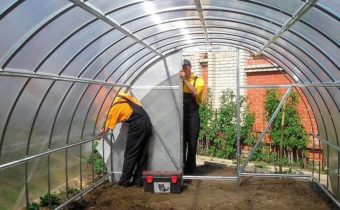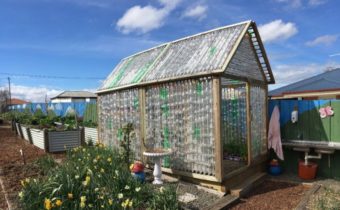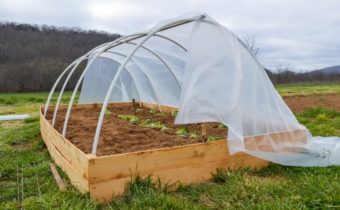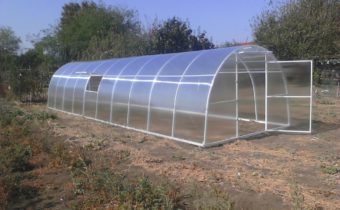Simple greenhouse stretch film
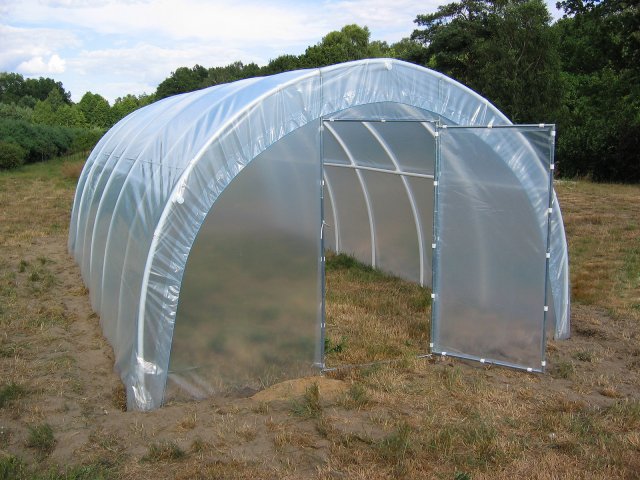
Building a greenhouse from stretch films does not require any special skills, tools or large expenses. Low weight, transportability, simplicity, service life more than one season - therefore gardeners often choose such a structure.
To get a greenhouse reliable, convenient in operation, does not require constant repair, it is necessary to correctly determine the materials. The shape of the structure itself is also important, the correct calculations of dimensions, compliance with the installation technique.
Pros and cons
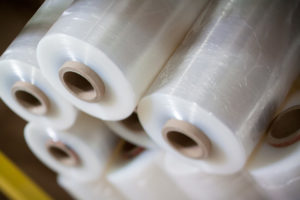
Stretch film is not intended to cover the landings, in contrast to the more expensive and less elastic greenhouse material. However, it has the advantages:
- can serve 2-3 seasons;
- does not deteriorate due to long-term storage;
- retains heat and moisture well;
- does not require additional fasteners.
The finished greenhouse for thermal insulation practically does not differ from the capital construction of cellular polycarbonate, but it is cheaper and has a low weight. Several layers of material between which the air, delay the temperature, reduce the negative impact of direct sunlight. The primary film is permeable to the UV spectrum, so the plants get all the necessary substances, ripen noticeably faster.
The use of a secondary type is undesirable. On its surface may be oil droplets, and the transparency is at least 40 percent lower.
At construction of the greenhouse it is possible to refuse almost completely difficult fixture. The elasticity of the material allows you to create complex shapes, while reducing the load on the main frame. The speed of construction increases markedly.
Inside such a greenhouse the air will warm up instantly, but in hot and sunny weather it can be dangerous for plants. If you do not provide special flaps for ventilation, the design can be used only a few months a year. It is extremely difficult to make moving elements out of such material, which is also called stretch among the shortcomings. Such a greenhouse quickly loses its initial form: the generated electricity literally attracts dust to itself, so it is necessary to regularly wash the surface to ensure the access of the sun to the plants. Because of the structure, it's not easy.
Glass greenhouse do it yourself
Glass greenhouses - one of the most durable options. It is structurally more complicated than a simple greenhouse made of geofabric ...
Important parameters
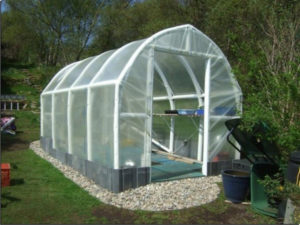
Winding stretch film - an easy way to update the existing greenhouse. The finished frame of any type of material will be suitable. However, special attention should be paid to the choice of film. If the construction will have to start from scratch, it is necessary to choose the type of construction, its size, and even the type of foundation.
Basis and materials
The foundation for such a greenhouse is not required. If the frame is heavy, for example, wooden, capital, then it is permissible to make a small base of timber or brick. Thus, it is possible to exclude rotting of the main supports. If propylene tubes are used as a frame, you can do with a standard seal of the selected area. With large wall sizes, a height of more than one and a half meters, it is necessary to secure the greenhouse frame securely on the ground. The film after stretching will not be elastic, so the wind will act on the whole area.If the ground allows, mono deeply dig support, a more reliable option - strengthening the bottom strapping of heavy materials.
Choosing a stretch film, you should pay attention to the thickness, raw materials and barrier properties. You can compare several types by the parameters shown in the table:
| Film type | Thickness | Barrier properties |
| Kling film | from 5 to 11 microns | low breaks easily |
| PVC | from 20 to 30 microns | medium, torn with effort, but passes heat |
| EVA | from 13 to 20 microns | high, has the best thermal insulation performance |
| polystyrene | from 7 to 18 microns | medium, tearing with effort, but less elastic |
The best option for the greenhouse will be films PVC or polypropylene. Kling materials are too thin; a minimum of 5-7 layers will be required for sufficient warming, but the transparency in this case drops sharply. Polystyrene compounds are too inelastic, EVA films have better mechanical characteristics, but their cost is several times higher, therefore it is not recommended to use them for homemade greenhouses.
In Europe, PVC products are not used because they are considered toxic. But in some countries this prohibition does not exist.
When working with a film, it is necessary to take into account its type in order to avoid typical mistakes. Polystyrene products weakly stretch, while PVC compounds can be lengthened by 3-4 times. The recommended rate of stretching is no more than three times. So, you can save the elasticity, elasticity, strength and achieve a strong connection of the layers of material. Thermal welding is not used: under the action of temperature, the stretch materials are melted and compressed, fixation does not occur. It is also unacceptable and piercing metal fasteners on free sites, where there is no strong support around the perimeter. Carefully need to use any adhesive formulations. Some chemical elements can literally "eat through" the film.
Design
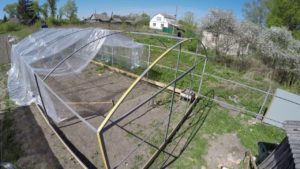
The optimal design is arc-shaped. It can be assembled from vertical supports and film, nothing else is required. In this case, you can achieve almost any height by selecting the frame of the required thickness. This form does not require the construction of the base or roof, if necessary, you can replace each individual element.
Choosing the shape of the future greenhouse, it is necessary to take into account the level of snow load and the possible impact of condensate. If the calf is year-round, stingrays are obligatory. It is extremely difficult to build a gable roof from a film, the arc shape, in turn, will not allow snow to build on top of the structure, therefore a collapse is unlikely. Inside the condensate will flow along the walls, which is also desirable. The soil is thus moistened, no drops will fall on the leaves.
Calculations
To determine the required amount of materials, you need to use several basic parameters. Firstly, grown crops: if these are bush vegetables, the height of the greenhouse should be at least 1.5 times the maximum, for greens and cucumbers less than, a minimum of 70-80 centimeters is required. But this design is very difficult to maintain. The optimum height is considered 150-170 centimeters. If you plan to plant one bed, it will be enough to 1 meter wide. Secondly, if there are several greenhouses nearby, between them you need to plan paths 30 centimeters wide, so you can go in, put a bucket, even bring a garden wheelbarrow.
If several greenhouses from the film are located nearby, it is also necessary to leave a distance between them so that you can wash the outer sides of adhered dirt.
The number of vertical supports is calculated based on the desired length. If the wind load is Neva, it is enough to set the arc every 2.5-3 meters. Otherwise, a more dense frame is needed: supports every one and a half meters. The same applies to any type of base, both metal and wood.When calculating the height of the supports, it is necessary to consider the presence or absence of the foundation. At least 50 centimeters each support in the absence of the lower strapping should be included in the ground.
When calculating the required amount of film, it should be noted that the best is a coating in 2 layers with an overlap of one third of the width. It is enough to calculate the perimeter of the frame, add one third to it, then multiply by two. Take into account the need and the so-called "skirt", which should protect the landing from blowing. It will take about 10 percent of the total length obtained. The finished value is divided by 2 to account for the stretching of the film. Thus, there will not be a large surplus, but the shortage of material can be avoided.
Greenhouse assembly
Assembly begins with the installation of the frame. If polypropylene arcs are selected, they are added dropwise to the pre-compacted soil. If necessary, perform the bottom trim: a wooden bar is laid along the perimeter, vertical supports are attached to it with corners and clamps. If the frame is wooden or metal, assemble it in the reverse order: first, the end walls, then the bottom trim, after all the vertical supports and the top trim.
For the winding of the finished frame does not necessarily remove or disassemble. Need to start from the top. For fixing, you can make one horizontal turn under all points of support, after which you can already wind. The first layer is made without an overlap, then the reverse motion is started from top to bottom with the overlap of each layer. So, the design turns out as warm and durable. If necessary, repeat all over again.
The most difficult part is the assembly of the door and the ventilation window. It is necessary to attach the film with a stipler to the frame. If these are propylene arcs, special clamps can be used. After the casement, the doors are fixed with a bead, targeting all layers of film to it. The same is done with the ventilation window. At the end, the openings themselves are cut with a sharp stationery knife.
Doors and windows, especially on a wooden frame, can be assembled separately, but the insulation in such a greenhouse may suffer.
Bugs and Tips
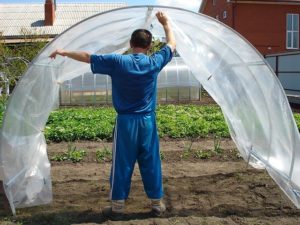
Stretch film can be fastened literally on any surface, due to the tension it holds even on smooth galvanized sheets. However, many gardeners make a typical mistake - they forget to check the quality of the frame before pulling the film. If there are notches on the metal, on the plastic there is a thin bloom, in places of bend the stretch will tear first of all in the first season. Therefore, before assembling it is necessary to process such areas with a file or a large sandpaper.
It is not necessary to save and leave areas with single-layer winding. Even if the ambient temperatures are not too low, a high level of thermal insulation is not required, layering is important. It makes the greenhouse more durable. Streych film is destroyed when heated in the sun, under the action of ultraviolet radiation. If it is only one layer of material, weak points will quickly appear, the whole structure will “creep away”. With multilayer winding base, the first round, is not subject to harmful effects.
Another common mistake is to ignore sail. The higher the greenhouse, the more it affects the wind. With a height of more than one and a half meters, it is recommended to be sure to fasten the bottom with diagonal straps. The same can be done at the top. If this arc greenhouse or greenhouse, you can additionally fasten the frame, stretching a kind of "horse" of the roof through all the supports.
Building a greenhouse from stretch film is a fairly simple task. The best design will be the simplest arc, it is stable under the influence of snow, not afraid of condensate and heavy precipitation, easy to maintain. The elastic film will last for several seasons, if you prepare the frame correctly and follow the installation rules.Excellent thermal insulation, high level of light conductivity, low cost are among the main advantages of this design.

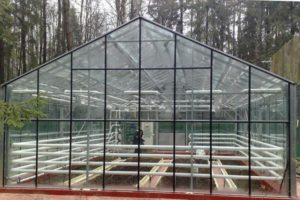

 (2 ratings, average: 4,00 from 5)
(2 ratings, average: 4,00 from 5)